
|
1A Grange Rd. Toorak 3141 Australia Ph. 9867 6405 |
|
You need X rays to see decay below the surface and between the teeth.
|

|
People often think teeth hurt simply when they have cavities. It is a little more tricky than that. Many teeth have decay lurking below the surface without any pain or warning signs. Sometimes it takes an X ray to detect trouble. The way a tooth reacts is a little like the �frog-in-a-pot� experiment where the poor frog does not notice the water being boiled if the heating is slow enough. If decay grows slowly, the nerve, or pulp shrinks back gradually does not register pain. There might be no sensation for quite a few years. If the hole gets too deep, though, the tooth can become a quietly ticking time bomb, with pulp degeneration, and eventually lead to big trouble such as an abscess! It is a good reason to see the dentist before symptoms arise. |
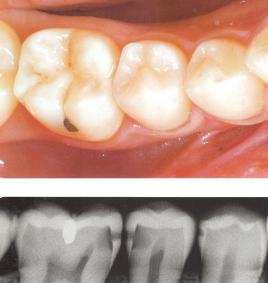
|
���.. To give an idea about how to address dental pain, here are three conditions �� �������� Sensitivity �������� Pulp Infection �������� Cracked Tooth Syndrome But don�t try to diagnose at home. See the dentist to find out for sure. |
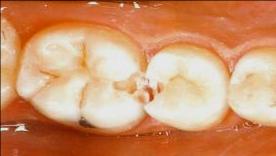
|
SENSITIVITY |
|
Many people complain that their teeth are painful with cold drinks or sweet foods. Their teeth are hypersensitive. This can be due to a number of causes but most times it can be traced to just one or two problems.� It is common to see grooves and hollows burrowing into the necks of the teeth, next to the gums. These cervical creavices are usually caused by brushing sideways with a hard toothbrush, retracting the gums and abrading the enamel. (It is important to brush hard, not sideways!) The resultant hollows can approach quite close to the inner pulp. In addition, acids can leach mineral out of the surface, making them weak and vulnerable to temperature change. The pH damage often comes from acidic drinks, like wine, Coke or sports drinks but digestive troubles and eating disorders can also bring acids to the mouth and attack enamel. The most common cause of acidity and acid damage , though, is simply plaque, poor diet and ineffective brushing. So, what can be done?
|

|
It strengthens the tooth�s chemistry by releasing mineral, kills bacteria by raising the pH and acts as a physical barrier against the cold. The process only takes a few minutes. In other sensitive spots, acid damage can be reversed but it needs a little help from the patient. This can be done by not only brushing smarter, but also by applying a couple of products to both strengthen the enamel and soothe the sensitive nerves underneath.
|
|
Neutrafluor 5000 Sensitive is a new toothpaste which contains five times the usual concentration of fluoride. It hardens teeth by promoting mineral uptake and converting their weak hydroxy apatite crystals into tough, acid resistant fluoro-apatite. In addition the paste�s potassium nitrate slows down nerve transmission in the pulp�s nerves to reduce the pain of sensitivity. Tooth Mousse (from the dentist) will also strengthen teeth but it does this by supplying the calcium and phosphate that make up the enamel and dentine and is often lost through acid attack. The paste also thickens the inner tubules, the tiny organ pipe structures that lead down to the pulp. |
|
ROOT CANAL THERAPY (ROOT FILLINGS) |

|
Most tooth decay goes undetected and, if it extends too deep, can lead to irreversible pulp or nerve damage and inflamation. If this happens a tooth might begin to hurt with eating or even just ache spontaneously for no apparent reason. In the worst case scenario the pulp actually dies, grows infection and the resultant bacteria spread into the jaw bone, creating an abscess. One would think a dead tooth could not hurt but this is no consolation if there is pain every time a tooth is bitten on, pushing it into the tender infected bone! Other factors can also harm the pulp. Physical trauma, cracks in the enamel or even just a history of deep decay and large fillings years earlier can also irritate the pulp to the point of no return. |
|
If the pulp is degenerating beyond repair, it is too late for a simple normal filling. It will not reverse the damage or relieve the symptoms.� A� root filling is needed. Root fillings sound painful but, in fact, are usually completely pain free. This is because the dentist anaethetises the tooth. Once the tooth is asleep there should be absolutely no pain! On the other hand the prodedure is time consuming and awkward; people get tired of having their mouth open. Basically the pulp is removed, the canal space cleaned and disinfected and a root filling of rubbery gutta percha placed to fill up the canal and prevent any further bacteria growing and causing infection. The principles are simple and the success rate outstanding but a good result requires attention to detail and a little bit of patience. The procedures usually take two or three vists to complete properly. Once the root filling has been done the challenge for the dentist is then to mechanically restore the tooth to strength. This can often be done by cementing a titanium metal post into one of the roots before filling over the top. The post limits the flexure of the tooth and reduces the chances of fracture. Root canal therapy is much easier these days because technology has given us strong, flexible nickel titanium cleaning instruments that can rotate rather than just oscillate and disinfect much more efficiently. The procedure is faster and more comfortable. See Newsletter No 29. |
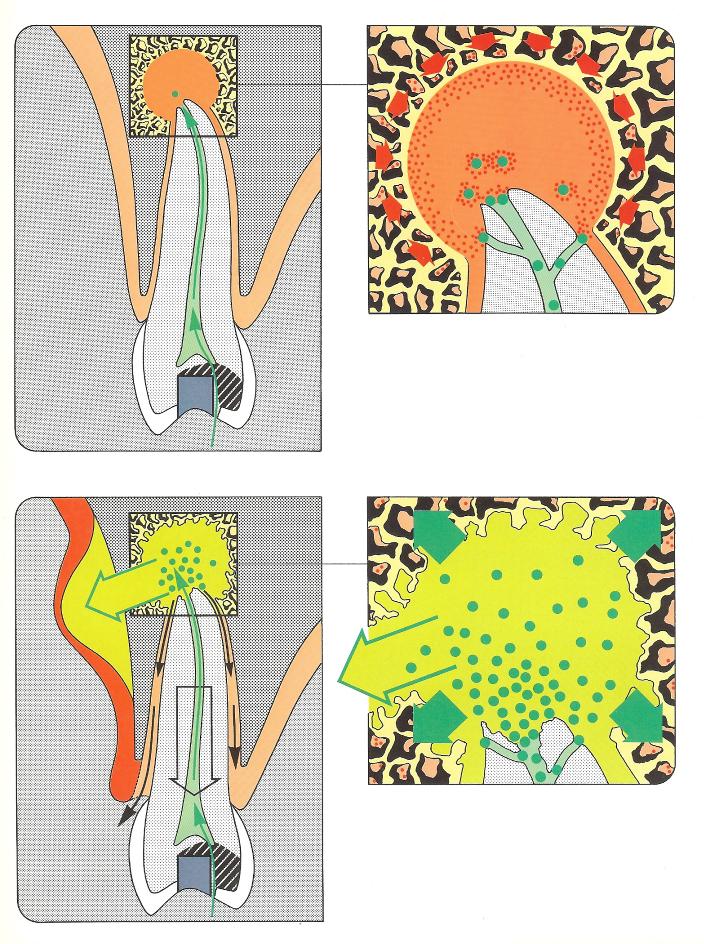
|
Decay can approach the pulp without immediately causing pain. Eventually though the pulp will suffer irreversible nerve damage. At this stage it is too late for a simple filling, the tooth will keep on hurting!
|
|
If the pulp is attacked too severely for too long, it can die, become infected and cause an abscess to spread into the jaw bone. Ouch! |
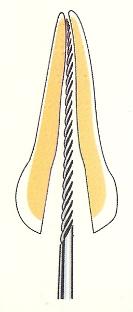
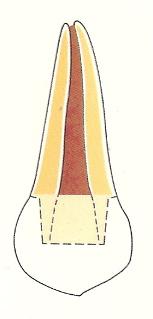
|
First the root canal is cleaned and disinfected, then it is filled with a material called gutta percha. |

|
The gutta percha should exactly fill the nerve canal. Accuracy and a tight seal at the apex of the canal are essential to prevent irritation to the tissues and prevent a recurrence of bacterial infection. |
|
An abscess can sometimes sit dormant for years if infection grows slowly and the surrounding bone resorbs at the same rate. At some stage, though, pain and swelling are bound to result when the infection �explodes�. |
|
CRACKED TOOTH SYNDROME |
|
Not all teeth that are cold sensitive or tender with biting have pulp infections or hypersensitivity.
Occasionally the trouble is cracks in the surface that extend into the body of the tooth, close to the pulp, and flex when the cusps are bitten at a particular angle. This will give sharp pain sporadically. If treated early enough there is usually no need for a root filling and the condition can most times be reversed. |
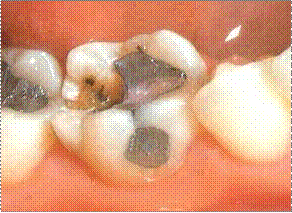
|
Most times the tooth is heavily restored with an old amalgam filling which is warping and failing to support the walls of the tooth. If this is replaced with a white bonded composite resin filling, the weak flexing cusps can be bound together and strength restored to the body of the molar.
|
|
Brush hard, but in circles, not sideways! |


|
Neutrafluor and Tooth Mousse work best together. Brush every night with the toothpaste, then rub in a little of the mousse. Do not rinse them off, simply spit out the excess. That way the goodies in each will have a chance to weave their magic. For details see Sensitivity and Tooth Mousse. If cosmetic bleaching is causing sensitivity see Whitening & Sensitivity. |
|
These pathways contain fluid and are designed to transmit temperature change but, when their bore is too broad due to mineral depletion, the fluid inside moves erratically, causing sharp pain. Remineralising the tubules narrows and even occludes their bore, so hot and cold are registered at a more civilized rate.
|
|
The hollows can easily be filled by the dentist bonding sedative restorative cement to the necks of the teeth. No drilling is needed, nor is an injection. This white material actually adhers to the surface and creates an impervious seal. |
|
����������������������������������������������� Crackline |

|
THE FROG IN THE POT (Do not try this at home!) |

|
People often have trouble understanding how a tooth can have decay, or even an abscess, without actually hurting. In fact it does appear surprising - small cavities and early infections regularly lead to terrible pain while large ones can often sit there dormant without any tenderness. On many occasions they are only discovered on X rays. The factor that determines whether symptoms develop seems not to be so much the size of a lesion but its rate of growth. A large, slow growing cavity frequently stimulates the nerve to shrink back and avoid the advancing bacteria. A nasty abscess, growing by increments, forces the surrounding jaw bone to resorb around it and, as a result, there is no obvious pressure build up. |
|
In both cases there may not be any hint of trouble until problems are advanced and complications are disturbing and painful. It is a little like the frog-in-a-pot experiment. If you throw a frog into a pot of boiling water it will immediately jump out, given half a chance. Conversely if you gently place your poor, unsuspecting frog in some cold water and gradually heat it up, the frog will bask there contentedly until it croaks. You will then have a fine dish of French frog�s legs but possibly suffer bad karma in another life time. There are two morals. Firstly, treat dental problems early and secondly, always check the thermostat on the jacuzzi. |